Abstract
Individual and work related risk factors in the development of occupational musculoskeletal complaints were studied in a group of 210 female production workers, mainly sewing machine operators. Another group of 35 female employees performing secretarial or laboratory duties were also included. The production workers had significantly higher symptom scores with respect to self reported musculoskeletal complaints than the group with more varied work tasks for the head, neck, shoulders, and arms, but not for the low back, hips, and the lower extremities. No significant differences were found in symptom level between geographically separate groups of production workers with similar work tasks. The main individual risk factor identified in this study was the experience of previous, similar symptoms in the same body region, but this factor only accounted for 2-3% of total variance in symptom score for the neck and shoulders. Other individual factors of importance for symptoms in the neck and shoulders were "signs of psychological problems" and "tendency of muscle tension," but these only account for about 1% of total variance in symptom score. Symptoms in the head and low back showed complex relations with individual parameters.
Full text
PDF
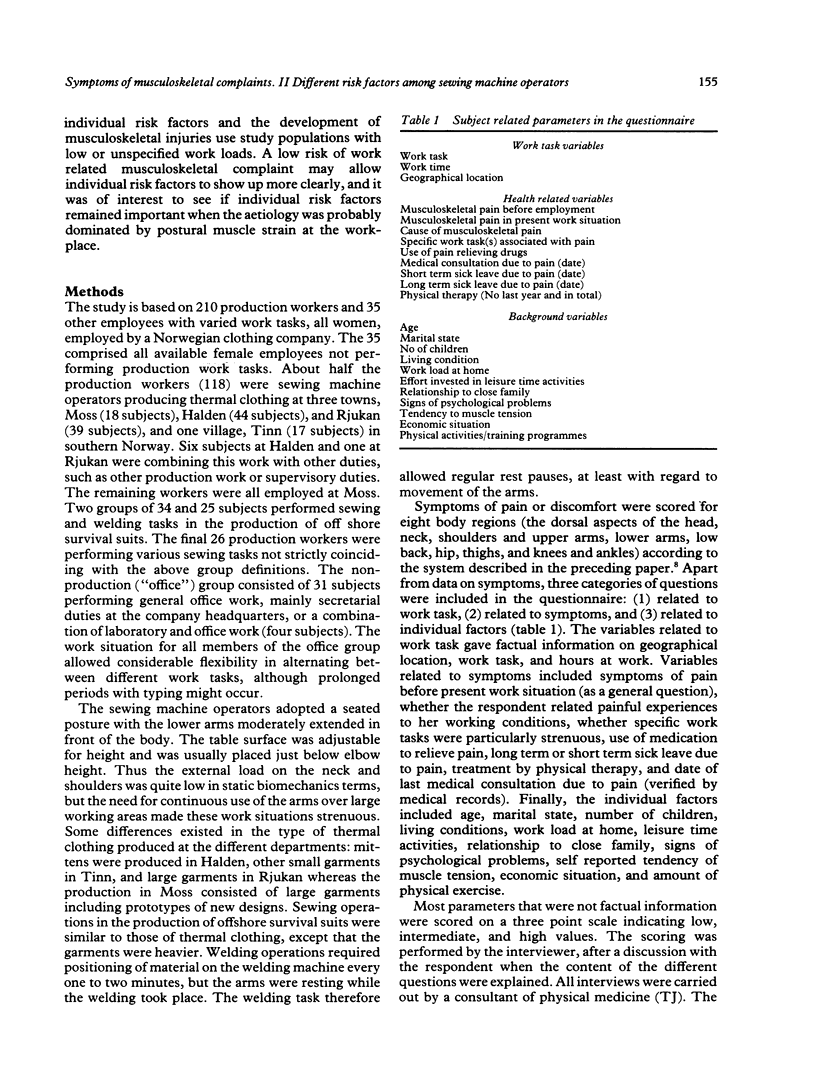
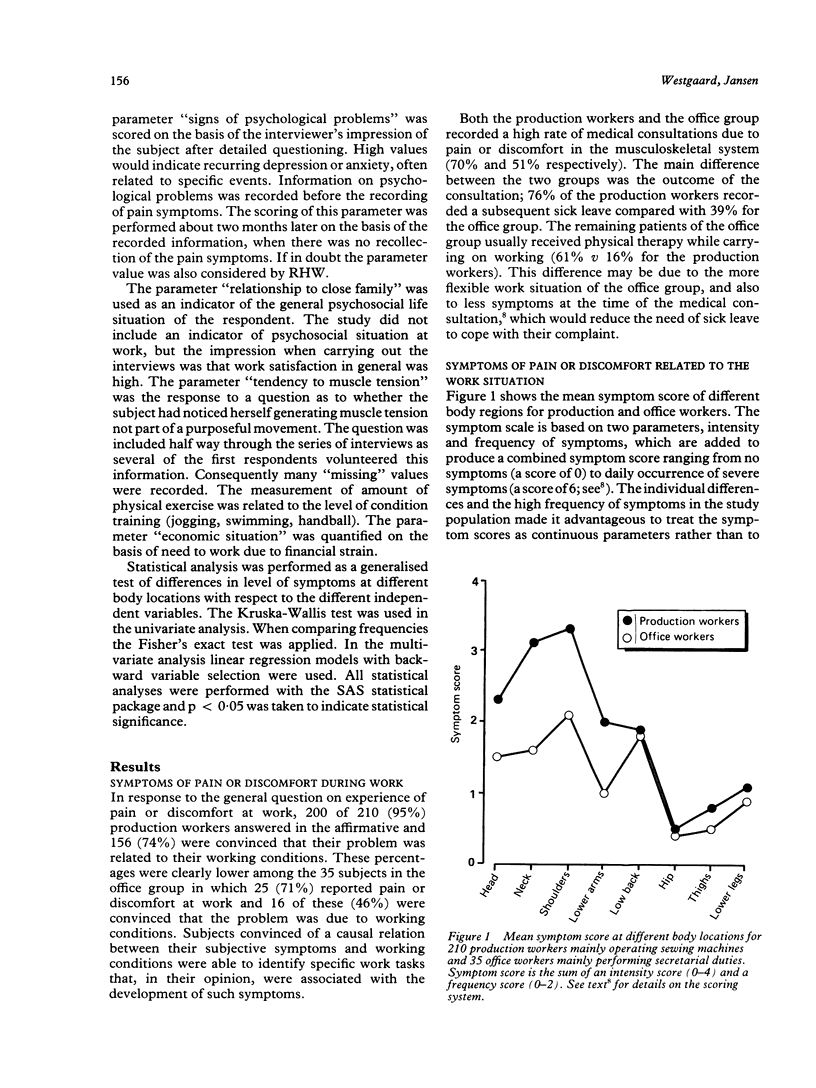
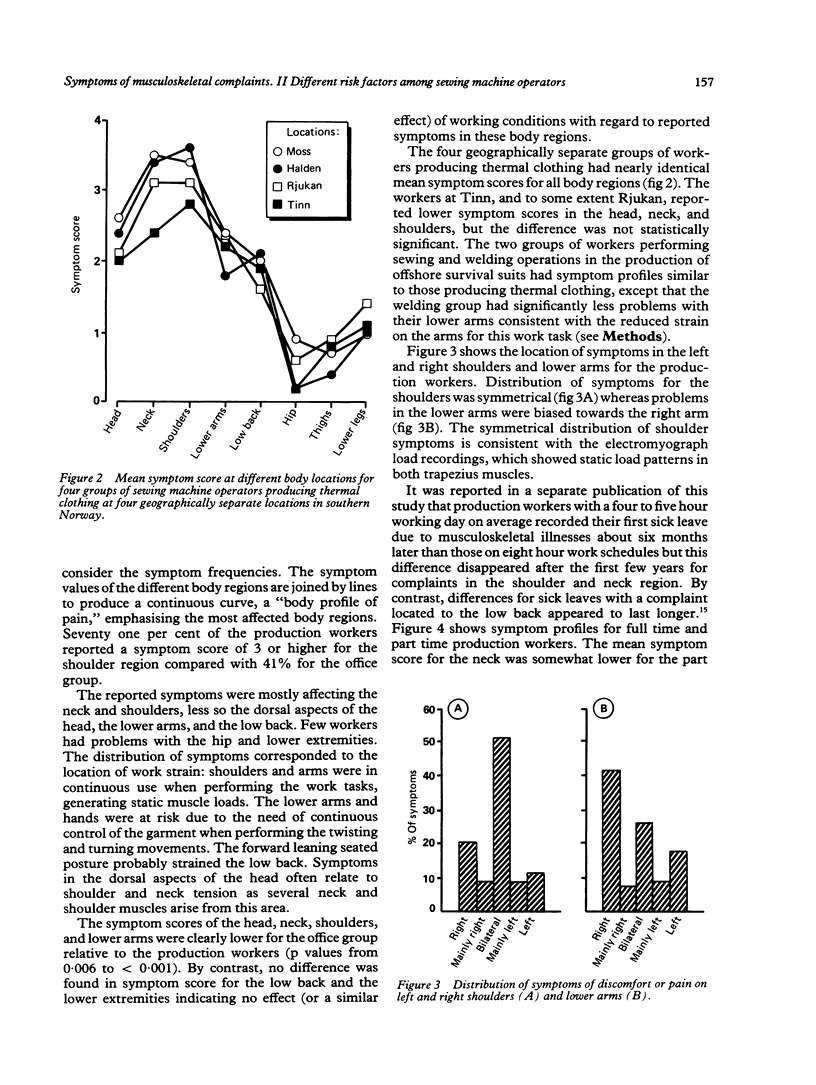

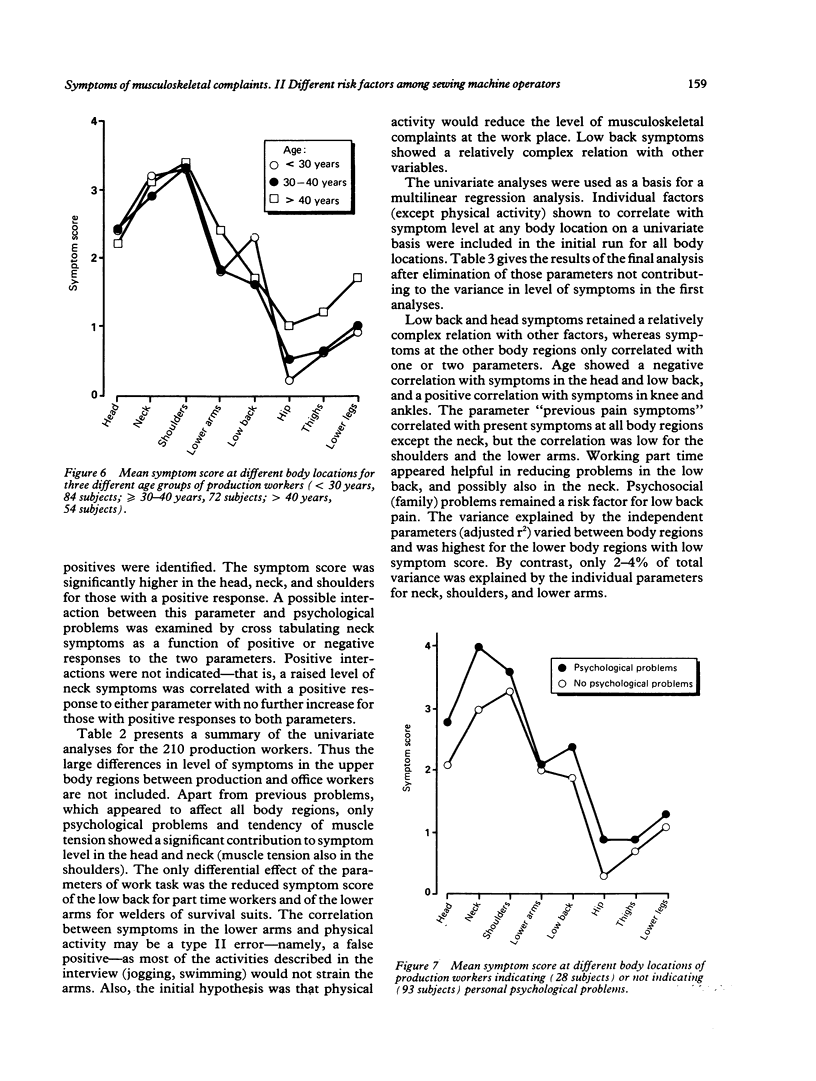
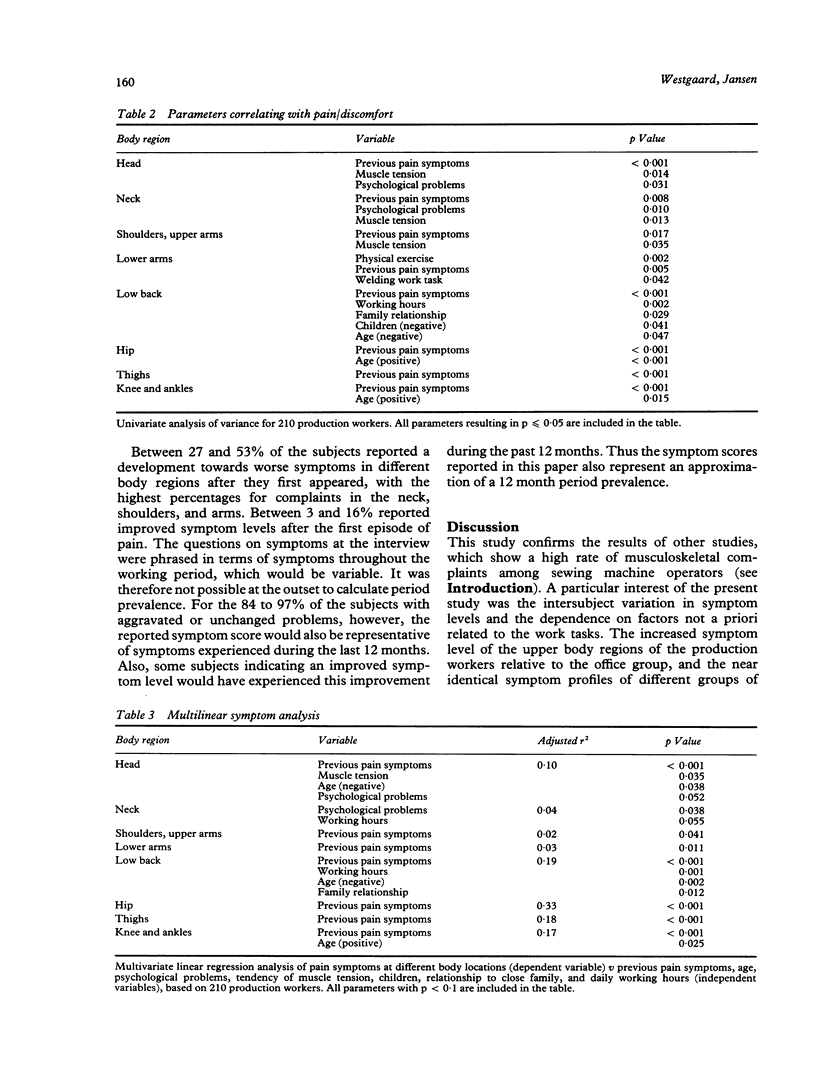
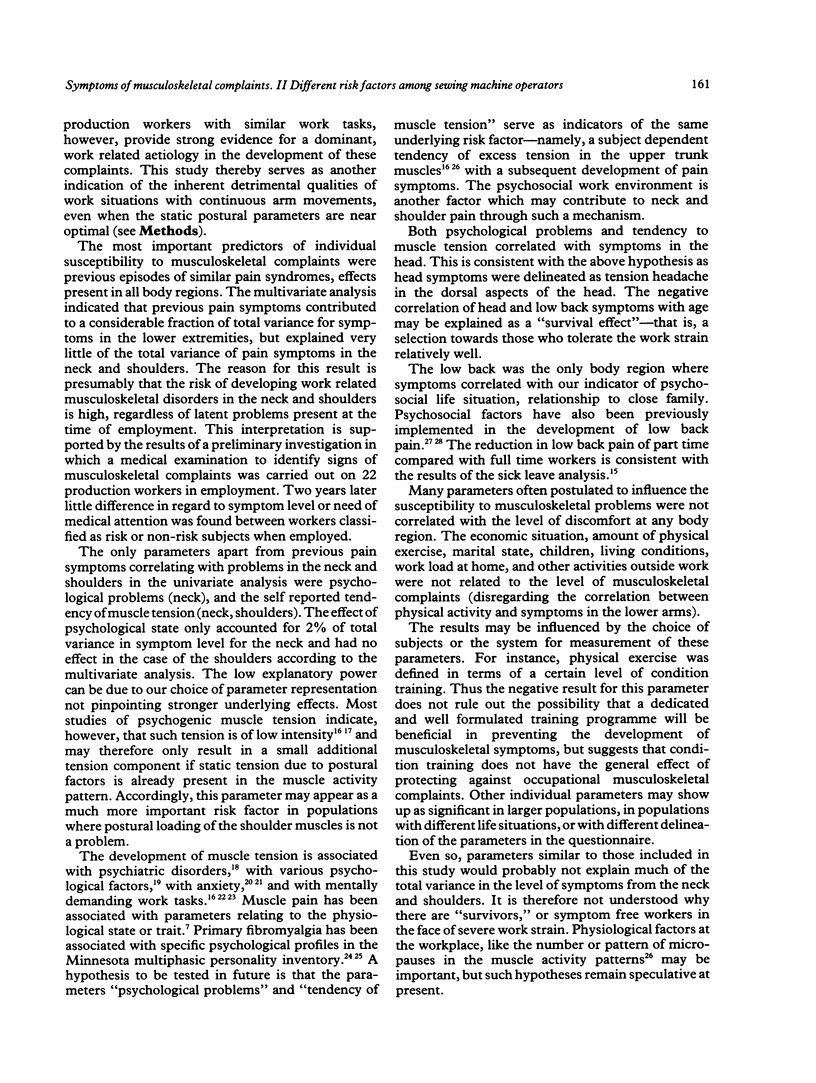
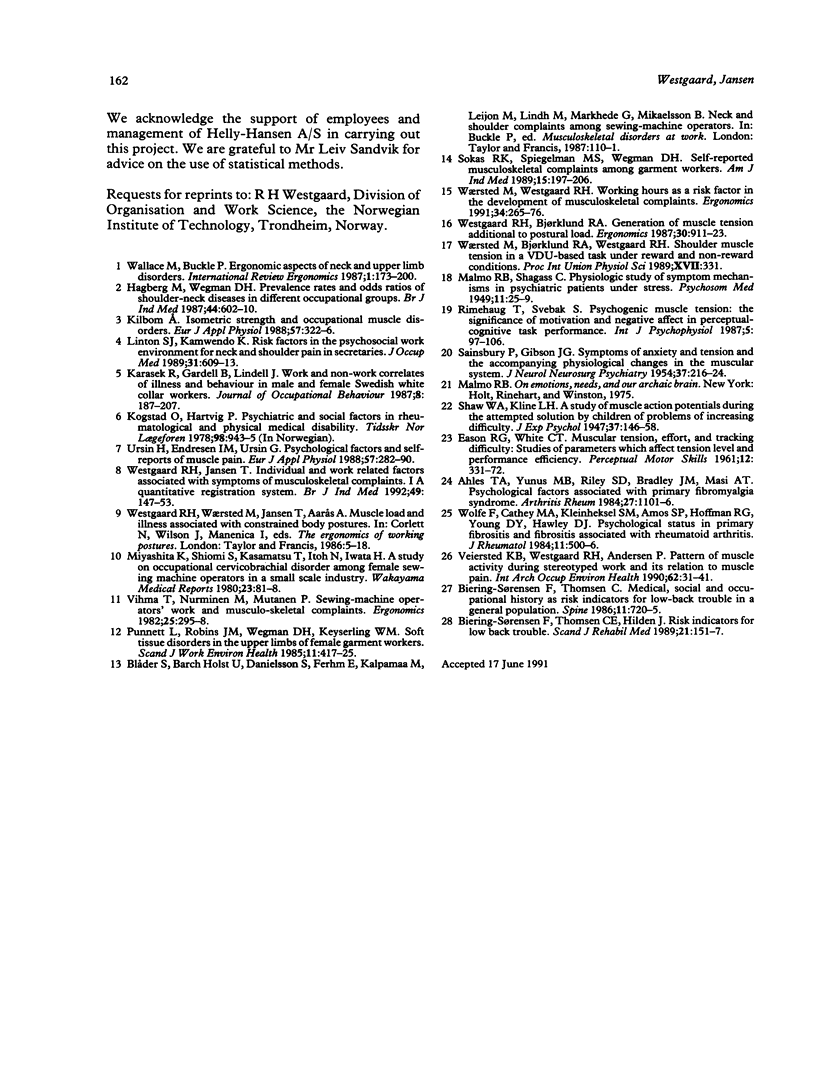
Selected References
These references are in PubMed. This may not be the complete list of references from this article.
- Ahles T. A., Yunus M. B., Riley S. D., Bradley J. M., Masi A. T. Psychological factors associated with primary fibromyalgia syndrome. Arthritis Rheum. 1984 Oct;27(10):1101–1106. doi: 10.1002/art.1780271004. [DOI] [PubMed] [Google Scholar]
- Biering-Sørensen F., Thomsen C. E., Hilden J. Risk indicators for low back trouble. Scand J Rehabil Med. 1989;21(3):151–157. [PubMed] [Google Scholar]
- Biering-Sørensen F., Thomsen C. Medical, social and occupational history as risk indicators for low-back trouble in a general population. Spine (Phila Pa 1976) 1986 Sep;11(7):720–725. doi: 10.1097/00007632-198609000-00011. [DOI] [PubMed] [Google Scholar]
- Hagberg M., Wegman D. H. Prevalence rates and odds ratios of shoulder-neck diseases in different occupational groups. Br J Ind Med. 1987 Sep;44(9):602–610. doi: 10.1136/oem.44.9.602. [DOI] [PMC free article] [PubMed] [Google Scholar]
- Kilbom A. Isometric strength and occupational muscle disorders. Eur J Appl Physiol Occup Physiol. 1988;57(3):322–326. doi: 10.1007/BF00635991. [DOI] [PubMed] [Google Scholar]
- Kogstad O., Hårtvig P. Psykiatriske og sosiale faktorer i reumatologisk/fysikalsk medisinisk uførhet. Tidsskr Nor Laegeforen. 1978 Jul 10;98(19-21):943–945. [PubMed] [Google Scholar]
- Linton S. J., Kamwendo K. Risk factors in the psychosocial work environment for neck and shoulder pain in secretaries. J Occup Med. 1989 Jul;31(7):609–613. doi: 10.1097/00043764-198907000-00012. [DOI] [PubMed] [Google Scholar]
- Punnett L., Robins J. M., Wegman D. H., Keyserling W. M. Soft tissue disorders in the upper limbs of female garment workers. Scand J Work Environ Health. 1985 Dec;11(6):417–425. doi: 10.5271/sjweh.2205. [DOI] [PubMed] [Google Scholar]
- Rimehaug T., Svebak S. Psychogenic muscle tension: the significance of motivation and negative affect in perceptual-cognitive task performance. Int J Psychophysiol. 1987 Jul;5(2):97–106. doi: 10.1016/0167-8760(87)90014-6. [DOI] [PubMed] [Google Scholar]
- SAINSBURY P., GIBSON J. G. Symptoms of anxiety and tension and the accompanying physiological changes in the muscular system. J Neurol Neurosurg Psychiatry. 1954 Aug;17(3):216–224. doi: 10.1136/jnnp.17.3.216. [DOI] [PMC free article] [PubMed] [Google Scholar]
- Sokas R. K., Spiegelman D., Wegman D. H. Self-reported musculoskeletal complaints among garment workers. Am J Ind Med. 1989;15(2):197–206. doi: 10.1002/ajim.4700150208. [DOI] [PubMed] [Google Scholar]
- Ursin H., Endresen I. M., Ursin G. Psychological factors and self-reports of muscle pain. Eur J Appl Physiol Occup Physiol. 1988;57(3):282–290. doi: 10.1007/BF00635986. [DOI] [PubMed] [Google Scholar]
- Veiersted K. B., Westgaard R. H., Andersen P. Pattern of muscle activity during stereotyped work and its relation to muscle pain. Int Arch Occup Environ Health. 1990;62(1):31–41. doi: 10.1007/BF00397846. [DOI] [PubMed] [Google Scholar]
- Vihma T., Nurminen M., Mutanen P. Sewing-machine operators' work and musculo-skeletal complaints. Ergonomics. 1982 Apr;25(4):295–298. doi: 10.1080/00140138208924956. [DOI] [PubMed] [Google Scholar]
- Waersted M., Westgaard R. H. Working hours as a risk factor in the development of musculoskeletal complaints. Ergonomics. 1991 Mar;34(3):265–276. doi: 10.1080/00140139108967312. [DOI] [PubMed] [Google Scholar]
- Westgaard R. H., Bjørklund R. Generation of muscle tension additional to postural muscle load. Ergonomics. 1987 Jun;30(6):911–923. doi: 10.1080/00140138708969787. [DOI] [PubMed] [Google Scholar]
- Westgaard R. H., Jansen T. Individual and work related factors associated with symptoms of musculoskeletal complaints. I. A quantitative registration system. Br J Ind Med. 1992 Mar;49(3):147–153. doi: 10.1136/oem.49.3.147. [DOI] [PMC free article] [PubMed] [Google Scholar]
- Wolfe F., Cathey M. A., Kleinheksel S. M., Amos S. P., Hoffman R. G., Young D. Y., Hawley D. J. Psychological status in primary fibrositis and fibrositis associated with rheumatoid arthritis. J Rheumatol. 1984 Aug;11(4):500–506. [PubMed] [Google Scholar]


